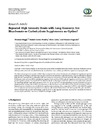Identificador persistente para citar o vincular este elemento:
https://accedacris.ulpgc.es/jspui/handle/10553/47360
| Campo DC | Valor | idioma |
|---|---|---|
| dc.contributor.author | Stöggl, Thomas | en_US |
| dc.contributor.author | Torres-Peralta, Rafael | en_US |
| dc.contributor.author | Cetin, Ebru | en_US |
| dc.contributor.author | Nagasaki, Masaru | en_US |
| dc.date.accessioned | 2018-11-23T12:56:19Z | - |
| dc.date.available | 2018-11-23T12:56:19Z | - |
| dc.date.issued | 2014 | en_US |
| dc.identifier.issn | 2356-6140 | en_US |
| dc.identifier.uri | https://accedacris.ulpgc.es/handle/10553/47360 | - |
| dc.description.abstract | The effects of varying recovery modes and the influence of preexercise sodium bicarbonate and carbohydrate ingestion on repeated high intensity performance, acid-base response, and recovery were analyzed in 12 well-trained males. They completed three repeated high intensity running bouts to exhaustion with intervening recovery periods of 25 min under the following conditions: sodium bicarbonate, active recovery (BIC); carbohydrate ingestion, active recovery (CHO); placebo ingestion, active recovery (ACTIVE); placebo ingestion, passive recovery (PASSIVE). Blood lactate (BLa), blood gases, heart rate, and time to exhaustion were collected. The three high intensity bouts had a duration of , and s demonstrating a decrease from bout 1 to bout 3. Supplementation strategy had no effect on performance in the first bout, even with differences in pH and bicarbonate (HC). Repeated sprint performance was not affected by supplementation strategy when compared to ACTIVE, while PASSIVE resulted in a more pronounced decrease in performance compared with all other interventions. BIC led to greater BLa, pH, and HC values compared with all other interventions, while for PASSIVE the opposite was found. BLa recovery was lowest in PASSIVE; recovery in pH, and HC was lower in PASSIVE and higher in BIC. | en_US |
| dc.language | eng | en_US |
| dc.publisher | 2356-6140 | - |
| dc.relation.ispartof | The Scientific World Journal | en_US |
| dc.source | Scientific World Journal[ISSN 2356-6140],v. 2014 (145747) | en_US |
| dc.subject | 241106 Fisiología del ejercicio | en_US |
| dc.title | Repeated high intensity bouts with long recovery: Are bicarbonate or carbohydrate supplements an option? | en_US |
| dc.type | info:eu-repo/semantics/Article | es |
| dc.type | Article | es |
| dc.identifier.doi | 10.1155/2014/145747 | |
| dc.identifier.scopus | 84912570967 | - |
| dc.contributor.authorscopusid | 56394691600 | - |
| dc.contributor.authorscopusid | 56431163500 | - |
| dc.contributor.authorscopusid | 7006717241 | - |
| dc.contributor.authorscopusid | 7005461975 | - |
| dc.identifier.issue | 145747 | - |
| dc.relation.volume | 2014 | - |
| dc.investigacion | Ciencias de la Salud | en_US |
| dc.type2 | Artículo | en_US |
| dc.date.coverdate | Enero 2014 | |
| dc.identifier.ulpgc | Sí | es |
| item.fulltext | Con texto completo | - |
| item.grantfulltext | open | - |
| crisitem.author.dept | GIR IUIBS: Rendimiento humano, ejercicio físico y salud | - |
| crisitem.author.dept | IU de Investigaciones Biomédicas y Sanitarias | - |
| crisitem.author.orcid | 0000-0002-0848-4260 | - |
| crisitem.author.parentorg | IU de Investigaciones Biomédicas y Sanitarias | - |
| crisitem.author.fullName | Sanchez De Torres Peralta,Rafael | - |
| Colección: | Artículos | |
Citas SCOPUSTM
10
actualizado el 08-jun-2025
Visitas
125
actualizado el 01-nov-2024
Descargas
121
actualizado el 01-nov-2024
Google ScholarTM
Verifica
Altmetric
Comparte
Exporta metadatos
Los elementos en ULPGC accedaCRIS están protegidos por derechos de autor con todos los derechos reservados, a menos que se indique lo contrario.
